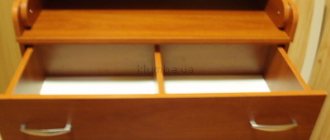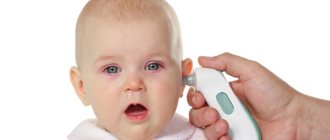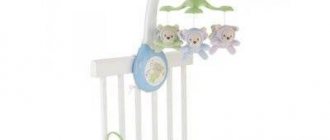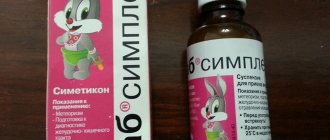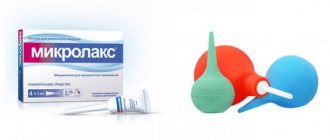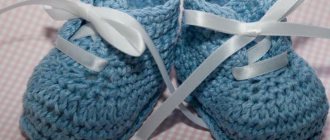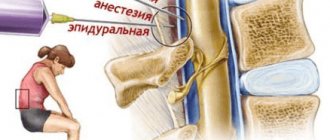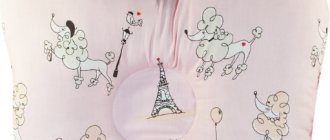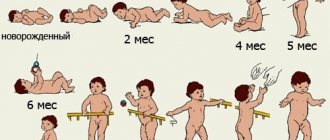As soon as a baby appears in the house, his first toy immediately appears - a rattle for newborns. At least, this should be so, because playing with rattles for newborn babies perfectly develops their vision and hearing. Therefore, rattles for a newborn baby are, as the British say, “a must,” i.e. a must-have toy. However, in order to properly develop a baby’s senses with rattles, you need to know how to do it. Here's what I found out.
Toys for little ones
A rattle for a newborn is not just an object, it provides tactile sensations, visual and acoustic. All rattles can be divided into types:
- Hanging rattles. They can be placed above the baby's stroller or crib. Moreover, they can be the most ordinary or with a music and moving module. Rattles on a crib for newborns allow the baby to concentrate attention on an object, be distracted from external stimuli and respond to sound.
- Rattles in the form of a ring. Their advantage is a comfortable grip and the ability to put it on a baby’s hand.
- Bracelets are rattles for newborns. The difference lies in the material used. They are sewn from soft fabric and equipped with Velcro. This item is easy to put on a baby’s arm or leg.
- Rustles. Another type of fabric toys are products with different fillings that make a rustling sound when moved.
- Sling toys. Fans of this movement often make such rattles themselves. Particularly popular are beads that the baby touches during feeding or gets distracted while in the sling.
- Teethers. To facilitate teething, special rattles have been developed that are comfortable for sore gums to chew on. As a rule, they are filled with water or gel filler. It is important that the surface of the teether is soft so as not to injure the gums, but also moderately hard so that a piece of the toy does not accidentally end up in the baby’s mouth.
A rattle for a newborn can be made from one material (plastic, fabric) or a combination of them. This option is interesting for the baby and more educational.
As the baby grows, interest changes
As we have already seen, a rattle is a useful thing for newborns, but one question remains: at what age and which version of this entertainment is suitable for a child?
Use the fact that he doesn't have much attention span to your advantage by switching toys frequently if he seems to be getting bored with something. And don't forget the child proof! She is learning to walk and she is becoming more active in general. Her attention span is greater and she is more interested in playing with you. She grabs, turns, digs, throws and falls. And she may remember more, although there will be no long-term recall until 2 or.
She can push it or throw it, and playing with it will not only make her happy, but will also help teach her about causes and consequences and develop hand-eye coordination. Whether on her mat, car seat, or anywhere else, it will keep her intrigued as she practices opening and closing flaps and doors, turning knobs, and pushing buttons. Stacking toys, including nesting cups, rings and blocks, while shape sorters will help her learn shape names and colors, but also allow her to practice her exciting new abilities of getting things in and out. Photo books. She can understand more of what you say even if she can't speak yet, and books are a great way to share your knowledge. Ask her to point to a cow or a bulldozer and see how quickly she knows the book by heart. Drum, tambourine, maraca, xylophone. She will probably love the fact that she makes this instrument sound like the sounds themselves.
- Forefront.
- Stacking toys and mold sorters.
- At this age, children love sorting.
Don't forget that she still loves her old rattles, animals, dolls and mirrors, especially since there are now so many more ways she can play with them.
- A newborn can carefully follow a bright object with his eyes from the age of two weeks. At this time, the baby can also hold a small object in his fist, due to the developed grasping reflex.
- The three-month-old baby already consciously holds the rattle in his hand, begins to wave it and pulls it into his mouth.
- He also begins to understand the shape and color of toys, responds well to sound, and some of them become favorites.
- At about four months, your baby will need teething rattles.
- If you are carrying a baby in a sling, then from five months you can give him soft toys so that the baby is busy with his own business and does not distract the mother.
- The six-month-old toddler consciously and happily plays with all his rattles.
Now we know that a rattle is not just a toy, but the first object through which a baby can learn a lot about the bright, diverse world around him, filled with sounds, smells and sensations. Delight your child with different games, develop him and enjoy his new skills with him.
We recommend reading: .
Child psychologist
After birth, the child enters the most important period of adaptation to the surrounding reality. The most important thing for him is the closeness of his mother and proper care. However, toys for newborns also play an important role in the development of the baby and his acquisition of useful skills.
You need to buy the first toys for children carefully and carefully. First of all, you should navigate the huge range of all kinds of gaming accessories for newborn babies. The basic rule is that there should not be too many toys!
In the first weeks, the baby has no time for entertainment, since he does not see very well due to the imperfection of the visual organs. Everything that is closer or further than 25-30 centimeters is perceived by the newborn as a cloudy spot.
Still, toys can be useful for sensory stimulation, especially if age-appropriate. For example, a traditional rattle is ideal for a newborn. Read about how to choose it and what types of rattles exist in our material.
The number 1 toy for a newborn baby is undoubtedly a rattle.
The first such products were made from natural materials at hand - birch bark, wood, willow vine, and animal bones.
Such objects were called trinkets, rustling things or rattles. In addition to its actual entertainment purpose, the first rattle also served as a kind of amulet against evil spirits and evil witchcraft.
Despite the constantly changing design, shape and complexity of functions, the very principle of operation of the rattle remains unchanged for several centuries. When shaking a hollow container filled with balls and other small objects, the child hears a quiet sound.
Benefits of rattles
What are the benefits of rattle toys for newborns? These items are designed for the all-round development of the baby:
- by the end of the fourth week, the child begins to determine the direction of sound, simultaneously improving auditory skills;
- the visual apparatus also improves: the child begins to peer at the toy, trying to catch its movement with his eyes;
- By placing a rattle in children's hands, parents develop fine motor skills of their fingers and teach them to hold the toy in their palms.
In children's stores you can buy rattles for every taste and size, but it would be correct to take into account the age of the baby, as well as the quality of the products chosen.
Many mothers advise stocking up on 2-3 rattles for the first time. For a newborn baby, who spends most of his time sleeping, such a number of toys is already a huge abundance.
Manufacturers today offer several types of noisy products. All of them are intended for babies, but not all of them are suitable for a newborn baby.
Let's take a closer look at the types of rattles.
- (from 0 months). They are mounted above the bed, in a stroller or in a car restraint system. Some toys are additionally equipped with a music block. At first, the child simply watches and listens, and then, at 3 months, he begins to grasp elements. Good to know! To develop the emotional sphere, a baby of one and a half months can be hung with rattles with the image of a smiling character. It is important that the mouth and eyes are clearly visible.
- Bracelets
(from 0 months). Bracelets worn on the leg or arm contribute to the development of motor skills. The child will begin to move his limbs more actively, wanting to hear the characteristic noise. You need to make sure that the rattle does not pinch the limb. - Soft
(from 3 to 5 months). These rattles are made from fabrics of different textures, which contributes to the development of tactile sensations. Children are also attracted to the unusual, “rustling” sound that the toy makes. - Rings
(from 3 to 5 months). The product looks like a keychain with keys, which are small objects. When they collide, they make a noise that attracts the child's attention. - Socks
(from 3 to 5 months). These products are put on children's feet, just like regular socks. The only difference is that the “muzzles” of the animals, which are attached to the socks, contain rattles that entertain the baby. - Teethers
(from 6 months). These rattles are a combination of a toy and a teether - a device with a cooling gel that relieves pain in the gums during teething. - Clubs
(from 4 months). On both edges of the holder there are bright balls or funny figures. Such products are ideal for developing the skill of grasping objects and holding them. - Suction cup
(from 7 months). These toys are attached to the dining table so that the child can clap and touch them, but they cannot be thrown down.
The traditional version of rattles is a figurine on a holder. Both the handle and the toy itself can be made of various materials. The main thing is expressiveness and pleasant sensations.
Types of materials
In order for a child to be able to play with rattles without risks to his health, it is necessary to choose a gaming accessory made from the right material. Most often, “noisy” toys are made of wood, plastic, fabric and silicone.
What is best for a newborn?
- Plastic
. Modern manufacturers prefer this particular material for making baby rattles. High-quality plastic toys are safe and come in a variety of colors and shapes. They are very easy to care for - just wash and dry. - Tree
. Ecological and natural material with a pleasant texture. They are distinguished by clean and pleasant sound and ease of use. The only negative is that it is quite heavy, and a child may inadvertently hit himself on the head with a wooden rattle. - Textile
. Most often, textile rattles are made of cotton with velor inserts. The filler can be anything. A huge plus is the ease and inability to injure yourself. However, such products get dirty quickly and will have to be washed constantly. - Silicone
. This material is used in the production of teething rattles. Typically, the filler in silicone toys is liquid, so it is important to monitor the integrity of the coating of the gaming accessory.
In the first months of life, it is best to give your baby silicone or fabric rattles. The baby is still learning to control his movements, so he may accidentally hit himself on the forehead with his favorite toy.
As we grow older, the range of materials for rattles expands significantly. By six months, a baby can already play with toys with a variety of textures. This promotes faster development of tactile sensations.
What toys does a tiny newborn need? First of all, they are safe.
And in order to choose a really useful rattle, you need to follow several rules when visiting the store:
- Purchasing rattles on the market, from a tray, is completely excluded. Make purchases only in specialized children's stores or pharmacy chains. It is important to make sure that the product is certified and meets Russian and international standards.
- You must smell the toy before purchasing. A pronounced chemical “aroma” indicates the low quality of the materials or dyes used. Naturally, you cannot buy such rattles.
- Inspect the product carefully. It is necessary to make sure that the toy does not have chips, burrs, sharp corners and other defects that could injure the delicate skin of the child.
- The color of the toy purchased should be natural, not “poisonous”. Excessive variegation and brightness are a possible sign of a low-quality product. In addition, natural shades are suitable for improving the visual apparatus.
- Check the toy for the volume of noise it makes. The sound should be pleasant and not harsh, otherwise the children will get scared and cry. By the way, the most pleasant sound is made by wooden rattles.
- You can also check the weight of the purchased product. Infants will not be able to hold in their hand an object whose weight exceeds the 100-gram mark.
- If you want to buy a teething rattle, make sure that the toy is intact, since the liquid filler may leak if the “container” is damaged.
Toys for newborns and older children should be solid, without small elements that can fly off and clog the baby’s airways.
A rattle can be given to a three-week-old baby, but he will only take it because of his developed grasping reflex. Of course, in this case there is no need to talk about any independent game.
An adult demonstrates the first toys for a newborn. He does this in such a way that a helpless child who knows little can notice and become captivated by the rattle.
The toy is brought to the child’s face at a distance of 25-30 centimeters and moved smoothly from one side to the other, jingling it a little.
This way the child will be able to focus his eyes and hear an interesting sound.
The duration of the game is no more than 2 minutes.
A two-month-old baby is already more developed than a newborn baby. At the age of two months, the mother can place a rattle in the baby’s hand so that the baby learns to hold toys and manipulate them (for example, bring them to the mouth for study).
A three-month-old baby begins to become more skillful and independent. He is already able to take a toy from his mother’s hands, clasp it in his fist and carefully examine it. Some children try to rattle it, freezing in surprise when they hear the sound.
Rules for choosing a rattle
When choosing a baby's first toy, consider the following criteria:
- Product safety and environmental friendliness. A rattle for a newborn must have a certificate of conformity and be made from safe materials. It is important that the paint is not peeling, that the product does not have sharp edges, and that it is durable enough to withstand drops and knocks.
- Brightness, varied texture and geometric shapes. A newborn is interested in bright and varied toys.
- Type of filler. It is important to have rattles with different sounds. It may be ringing, rustling, crackling, or crunching. The acoustic effect produced by the toy attracts the baby's attention, he learns to respond to sound, looks for its source and rejoices when he finds it. However, when choosing, you need to make sure that the filler is reliably protected and will not fall out under any circumstances.
- Easy to care for, can be boiled or washed. The rattle often ends up in the child's mouth and then flies to the floor. Therefore, it is important that it withstands repeated cleaning procedures. It is necessary to pay attention to the markings. Plastic ones should have a mark that says they can be boiled, fabric ones should be washed.
It is necessary to provide the baby with different types of toys. To develop eye contact, you will need rattles for your newborn crib. To develop grasping movements, you will need objects in the form of a ring. Musical products are recommended to impact the infant's hearing.
What toys to choose for a child
We learned at what age a child should begin to pick up and hold objects in his hands. But to develop skills and safety, you need to choose the right toys. A rattle is a suitable option for the first lessons. Choose products with a long handle of about 15 centimeters. Then gradually move on to smaller things.
Toys should be bright and musical. Choose red, yellow, green, orange colors. Use objects with different shapes and textures. It also develops tactile sensations and fine motor skills, shapes preferences and taste. A rattle will be useful in the first month of a baby’s life, even if he does not yet know how to hold objects. Babies are already responding to sound.
In the first six months, two or three rattles of different colors and sizes, one or two hanging toys that hang in a crib or stroller will be enough for the baby. Additionally, you can use a music mobile, but not every child likes it. If you use musical hanging products for children under two years old, hang mobiles and similar toys no closer than 40-50 centimeters so that the baby does not get scared.
By six months, you can take moving toys and educational products of different textures. But they should not make too loud and sharp sounds, be large, and should not be bulky or heavy, so as not to frighten or injure the baby. In addition, the baby should be able to hold objects easily and comfortably. You can find detailed development of the baby by month at the link.
Toys are an important part of a dowry for a newborn. Arriving at the store, new parents are sometimes confused by the colorful variety of the offered assortment. It’s easy to get confused here, so it’s important to decide in advance what you need to buy in order to avoid useless extra costs. So, the main toys in the first months of a baby’s life should be rattles for newborns.
A simple and even sometimes primitive rattle has an impact on the mental, physical and emotional development of the baby, so it is important to take the choice seriously.
How to choose a rattle?
When purchasing, you should pay attention to the following points:
- the material
from which the rattle is made. It can be wood, plastic or fabric - a matter of taste, the main thing is that the toy is made of high quality, does not have sharp corners and seams, or foreign odors; - color
. It is better to choose rattles in bright, contrasting colors; pastel colors will not attract the baby’s attention. The paint must be of high quality and not peel off the product; - the sound
the toy makes. It should not be sharp, but sufficiently intelligible and loud. Choose several rattles with different sounds - hollow ones with balls inside, melodic ones with bells, musical rattles with sounds of nature; - safety
. A good toy should be durable, smooth, and not have small parts that can easily come off or fall off. In order to be sure of quality, you should buy rattles from a trusted manufacturer in reliable retail outlets. Then you can be confident that quality standards are met; - the presence of additional functions and elements
on developmental rattles. A grown-up baby will appreciate the rustling, shiny, rotating parts, and he will be able to gnaw on soft teethers during the period of active teeth growth.
At what age should rattles be given?
In the first months of life, the baby, of course, will not be able to play independently, so it is advisable to purchase rattles for the crib and stroller. They should be hung at a distance of 40-60 cm from the child’s face so that he can focus his gaze on them. In addition, in the first month of life, you can begin to master simple games together with your baby - move a rattle in front of your face, again at a distance of 40-60 cm, so as not to provoke strabismus, for several minutes. Then you can diversify the movements - speed up, slow down, encourage the child to follow her with his eyes and turn his head. As your child grows, you can put a rattle on his hand so that he can try to manipulate it on his own.
For a baby aged 6 months or older, you should choose heavier ones, for example, wooden rattles in order to strengthen the fingers and promote the development of motor skills. Rattles in the form of garlands, consisting of balls of different sizes, which the baby can touch while controlling his movements with his eyes, will be interesting.
When does a baby start holding a rattle?
Many parents wonder how to teach their child to hold a rattle. This skill will develop by about 4-5 months, when the baby begins to show active interest in the subject of the game and pull his hands. Help him grab the rattle correctly. If something doesn't work out, try repeating the exercise. Later, the game can be made more difficult by giving the child a rattle that is less easy to grasp, thereby stimulating muscle development.
You should not fall asleep with a variety of rattles. 4-5 are quite enough, but it is better to use them for games in turns so that the child does not lose interest.
What toys are necessary for a newborn?
Toys occupy an important place in the list of children's trousseau. And here, many temptations await future mothers and fathers. What does a baby who is just beginning his acquaintance with the world really need?
It should be noted that toys are not essential items for a newborn baby. In the first weeks of life, he sees them with difficulty, because... his vision is not sufficiently developed: the child cannot yet focus his gaze on objects and sees everything that is further from him or closer than an arm's length as blurry spots. He does not yet know how to follow moving objects. What can we say about the fact that the baby will be able to take the toy in his hand and hold it only a few months later! Therefore, the baby will get acquainted with the first toys only for a few minutes a day and mainly with the participation of an adult who will show him the toys and encourage him to follow their movements.
“Toy number one” for a baby in the first month of life is a rattle.
Along with traditional rattles, there are also small electronic musical toys - they are also suitable for the first games of an adult and a baby. Rattles intended for little ones have a diameter of 6-8 cm.
For babies, rattles are also produced, connected into garlands like beads - they are attached to a crib or stroller. For activities with your child, you can also purchase a bright one made of fabric; At first, an adult will show it to the baby, and over time the baby will be able to get to know it on his own. Such a rattle will make the child's tactile sensations more varied. It can have a handle or be worn on the child's arm or leg, like a bracelet.
Charm toys
are also attached to the crib, but with the help of an arc or bracket. Later, when the baby grows up, they can be attached to the playpen.
In the last decade, another toy for little ones has appeared on sale - a mobile phone. This is a kind of carousel that can spin and on which rattles or other small toys are attached. The mobile can be mechanical (in this case it is started with a key) or electric (such toys are battery-powered). When moving, most mobile phones play a soft, pleasant melody.
Manufacturers sometimes indicate the age “from O” on some other toys, including, for example, children’s construction sets. However, they can only be used theoretically for playing with newborns - everything except mobile phones and rattles will be useful to the baby only after a few months.
How to choose your first toys and how to use them?
A mobile is not a cheap toy, and the baby will only need it in the first 1-2 months of life. But it is not at all necessary to purchase one: a few ordinary rattles suspended above the child’s crib will be quite enough for his normal development.
If you still decide to buy a mobile, when choosing it, look at what the toys look like from below, because this is the angle from which the child will see them.
Listen carefully to the sound of a rattle or mobile phone: the sound should not be sharp or piercing, otherwise it may frighten the child. It’s good if all the rattles you choose sound different, because the baby needs a variety of auditory impressions.
Let all the rattles you purchase be of various shapes and colors (this also applies to rattles attached to a mobile phone): this way you will make the baby’s first visual impressions more diverse. It is advisable that some rattles have a contrasting image of a face (for example, black eyes, a mouth and a nose on a yellow background): such a toy will attract the child’s attention, and it will be easier for him to focus on it.
When choosing a rattle, pay attention to the age of the child it is intended for (this information is usually indicated on the packaging). Keep in mind that although rattles are considered the first toys, not all of them are designed for newborns.
When purchasing a rattle, keep in mind that you are buying it “for growth”: the child will not always just look at it - the time will come when the baby wants to hold it in his hands and try it on his teeth. Therefore, pay special attention to safety. Buy children's toys only in specialized stores that cooperate with well-known companies that produce children's goods and in no case on the market; Only in this case can you be sure that the toy is made of non-toxic material.
Choose toys made of soft plastic - hard plastic can crack, and sharp pieces breaking off from the rattle can cause injury. The toy should not have small parts that can easily come off. As your baby grows and begins to explore the rattle on his own, he may tear off or bite off these parts and swallow them.
Think about the “future” of the toy in terms of the child’s development: choose rattles with a comfortable rod-shaped handle: after 3-4 months the baby will be more comfortable holding such a toy on his own. It’s good if the surface of the rattle handles is different to the touch, because the baby will need different tactile sensations. By purchasing rattles that are suitable for both toddlers and older children, you can save a lot of money.
You shouldn’t shower your child with toys: 3-4 rattles (if you don’t have a mobile phone) are quite enough. Moreover, you should not hang all the rattles at once, but 1-2, changing them periodically, above the crib or stroller (40-60 cm from the child’s face - it is at this distance that he can distinguish objects). The same principle applies to using a mobile: it is advisable to change the toys attached to the carousel every few days. Monotonous toys will quickly become familiar to the child and will not arouse his interest.
Children develop hearing abilities and reactions to sound in the womb. Unborn babies hear voices and music. Knowing this, many parents begin to test their hearing from the very first days, putting their baby through tests that are too much for him to bear. Don't rush things. The first expressive signs, when the child begins to respond to rattles and other sound stimuli, appear no earlier than 2–4 weeks. This is explained by the fact that weak connections between the parts of the visual and auditory apparatus make it impossible to efficiently collect and process information. The baby hears, but is still too small to react to the sound and dispel the parents’ concerns. Give him time to master and get used to the variety of sounds, the abundance of visual images and the novelty of tactile sensations.
When is a rattle needed?
A baby needs a rattle literally from birth. Starting from two weeks of age, the baby is able, while in his mother’s arms or in his crib:
- follow a moving object;
- concentrate on sound;
- calm down when hearing sounds.
At this age, the grasping reflex is highly developed. Therefore, if you put a rattle in a child’s hand, he will hold it. For this, the most convenient are rings or ovals, with filler or pendants. But you should be prepared for sudden movements.
To prevent the baby from dropping the item, he will need a rattle bracelet for the hand for newborns. Soft Velcro does not cause discomfort, and bright colors and unusual sounds attract the baby's attention, force him to look for the source of the sound and concentrate his attention on the object.
When to give a rattle to a newborn? Pediatricians advise starting at the age of two weeks. By this time, the baby is able to hold an object for a short time and respond to sound.
Diversity
In order for the baby to develop harmoniously and gain an understanding of the different properties of the things around him, parents are recommended to choose rattles of various shapes, colors and sizes. They also need to be changed from time to time.
From four months of age, hand-eye coordination really begins to develop. Your baby may not be quite there yet, so it's important to give her time and space to try. So if you are holding something, she may see the object and then look at her hand and then look at the object again, and it may take a while before she is actually ready to reach out and take it. If you give up before you do, you're missing out, so it's important to be present and let things happen at your own pace.
The modern market can more than provide a child with a variety of toys, and therefore impressions. Next we will talk about what types of rattles there are, what their purpose is, and you will see them in the photo.
How to play with him
A newborn cannot yet interact with an object independently. Therefore, to attract attention, you should hang pendants on a stroller or crib. For the baby to be able to focus his gaze, the distance from the face to the rattle should be within 40-60 cm.
Despite your young age, in the first month you can already try to play with the baby. To do this, the toy is held in front of the baby's face, stimulating him to move his eyes. The distance must also be at least 40 cm, otherwise the child may develop strabismus.
In order for your baby to be able to manipulate the object, you will need a rattle bracelet. It does not fall out of the handle, and the child watches it with interest.
Once the child reaches the age of 6 months, heavier and more functional items are required. For these purposes, wooden rattles for newborns have been developed. They promote the development of fine motor skills and strengthen the baby's hands and fingers. The most interesting, in this regard, are toys in the form of beads. Each can have different filling inside. Kids love to move the balls with their hands and at the same time they watch their actions very carefully.
At what month does a baby begin to hold toys?
As already noted, a superbly developed grasping reflex allows a child to hold small objects literally from the first days. If a parent gives him a plastic ring, the newborn will instantly grab onto it and begin to hold it.
Such actions take place without conscious control. In the same way, the child grasps the mother’s finger or clothing. Moreover, the strength of his grip is so great that sometimes he has to unclench his children’s fingers in order to free the object.
Despite the fact that a child is capable of holding toys from birth, he is not yet able to manipulate them. At this age, babies don’t even understand (and don’t see) what kind of object is in their hands. They act exclusively reflexively.
Rattle pendants can be accidentally touched by hands, after which the child begins to study the unexpected swinging and noisy object. However, again, these actions cannot be called a game. In addition, such moments can frighten the baby, so you should hang toys higher.
Conscious holding and holding of toys begins at three months of age. If you put a rattle in a child's palm, it will immediately end up in the mouth - for the purpose of study and familiarization. A 3-month-old child carefully examines the toy, but shakes it unconsciously, not understanding the principle of its operation.
Six-month-old children are already well versed in the features of the rattle, knocking it on any surface with great pleasure. Including on your forehead. This is why you should not give your kids heavy toys, this way you will avoid bumps and bruises.
When the baby turns four months old, he will begin to take toys on his own, without prompting from adults.
There are several stages in this action:
- At the age of four months, the child begins to grab objects located at the level of his eyes. He holds the rattle with both hands and purposefully pulls it towards him for widespread study. Babies also knock on pendants and shake rattles to make sound.
- When the baby grows a little (after 5 months), he will begin to take objects from the surface of the bed or changing table with both hands. The raised toy is carefully studied, the baby tries to play with it. So far, most manipulations are performed with two handles.
- A six-month-old child takes the desired object from any position: lying on his back, tummy or side. The baby takes the rattle with one hand, the second at this moment can hold another toy. A 6-month-old child plays independently with rattles and develops favorite toys.
When the child reaches the age in which his skills allow him to pick up the desired object, it is necessary to begin an “inspection” of potentially dangerous things surrounding the baby.
Not many little ones can resist numerous temptations: after all, they want to explore the taste of their mother’s cream, and take a shiny fork from the table, and taste the tail or paw of a cat passing by. The thirst for knowledge is truly a great thing!
Rattles are the first baby toys that appear at home. Noisy objects are designed to arouse in a newborn baby an initial interest in the environment and in obtaining information.
In order for the baby to develop correctly from the first days, it is necessary to purchase only safe rattles that are suitable for his age. Explore the world around you without any problems!
Newborns are not yet able to use their hands, control movements, or hold objects in their hands. But already in the third week of life they can get carried away by bright things and follow the toy with their eyes. The baby does not yet control his movements, but the grasping reflex is well developed almost from birth.
After two months, the baby begins to wave his arms and legs, and by four months he is already consciously picking up and holding objects in his hands. Let's take a closer look at how many months a child begins to hold toys in their hands on their own.
Rattles, depending on age
Rattle toys for newborns come in a wide variety. Their choice depends on the age of the baby. For newly born children, hanging toys are required. They cannot yet contact an object or hold it for a long time, but they are able to fix their gaze on a bright object and respond to sound.
You can hang a regular stretcher on the crib and attract the child yourself. To provide mom with a free moment, you can install a music mobile. Such toys develop a child’s hearing and teach him to fix his gaze.
The baby is already three months old
Parents are often interested in the question of when the baby will be able to hold an object, and which rattle to choose for a newborn. At the age of about three months, the child already consciously grabs the toy, confidently holds it in his fist and drags it into his mouth. Therefore, a ring-shaped rattle is recommended so that it is easy to grasp. It is important that there are no small objects.
At this age, the baby is already reacting to multiple factors. He is interested in bright objects, different sounds, and differences in fillers. Parents may notice a baby's special love for a certain rattle. A variety of toys, differing in color, shape, material and filling, promotes the development of coordination, mental and emotional development and muscle activity.
How to teach a child to hold objects in his hands
- Do activities in the form of games, use conversations,... Be in a good mood, don’t raise your voice, don’t shout or get annoyed if the baby doesn’t succeed;
- Choose a time for games and activities when the baby is healthy, calm, and well-fed. It is important that nothing distracts or disturbs the baby. At the same time, do not leave the baby alone with the toy, otherwise he may be injured!;
- Perform the exercises in turn for each hand so that only right-handed or left-handed people do not develop skills;
- To teach your baby to clasp hands, regularly clasp your baby’s hands together so that he feels the squeeze of his fingers. Wrapping your hands around an object, such as a rattle or feeding bottle, helps;
- Get your child interested in a bright toy. Move the product in front of your face and rattle it. When the baby notices an interesting thing and begins to follow it with his eyes, put the object in the handle. Place the product across your palm between your thumb and other fingers. Help the baby connect his fingers and grasp the toy. At first he will hold things for a short time, but gradually the period of fixation increases;
- When the child is already holding the toy firmly and for a long time, vary the exercises. Start pulling the object, trying to take it away. This will improve the baby's reaction and increase muscle tension. As an educational game, use a patchwork rug with large buttons, beads and other similar items firmly sewn on;
- To develop a grasping movement, hang brightly colored items next to one of the handles. Let the baby show independence and develop movements;
- Help your baby shake the rattle and squeeze the squeaky toy. He will remember the movements and repeat them on his own. And to develop the skill of transferring an object from one handle to another, bring the free handle to the occupied one, let's touch the thing;
- Be sure to praise the baby when he was able to complete the task. This will allow the baby to rejoice and realize success, and will also provide incentives for subsequent activities;
- Keep toys clean, because babies put every object in their mouth, especially during teething. Therefore, you need to regularly wash or wash products, and plastic, rubber and glass items.
From 3 to 6 months
Children from three months to six months are very actively growing and developing physically and emotionally. For many, teething can begin as early as four months, so they will need teething rattles. The baby actively chews it, moves it in his mouth, thereby relieving inflammation in the gums.
For a five-month-old baby, rustling toys are of great interest. The baby interacts with them, plays with them and is surprised when different sounds are heard. This lays the foundation for the development of the development of the cause-and-effect relationship.
A child can independently interact with a rattle by the age of six months, most often by the time he masters the skill of sitting. At the same time, the child waves the object, knocks it, tests it, examines it. But my favorite activity is throwing a rattle from a stroller or crib. If mom picks her up, the activity turns into an exciting game. If parents don't pay attention, the baby gets upset and cries.
Attention to material
The most famous are plastic rattles. The best rattles for newborns should be colorful, easy to care for, lightweight and produce a melodious sound. The plastic version supports all these criteria. Transparent toys have become especially popular. At the same time, the internal filling is visible to the child, and he becomes interested in the movements of the internal filling.
Before purchasing, you should pay attention to the quality of the plastic and compliance with safety requirements. A conscientious seller is always ready to provide certificates of conformity.
Fabric rattles
These rattles are pleasant to the touch and, thanks to their different textures, guarantee tactile variety. Toys can be made of cotton fabric, velor, flannel, fleece. Knitted rattles with bells and bells placed inside are popular.
Sound diversity is provided by various rustling sounds. They are pleasant to touch with your hands, squeeze and squeeze. However, different parts of the rattle may differ. On the one hand, it is soft, on the other, rough. Such objects develop tactile sensations and fine motor skills.
To ensure hygiene, fabric rattles must be washed. In this case, all plastic elements must be removed. It is not recommended to purchase rattles with small parts and glued decorative elements.
Wooden rattles
Wooden toys are environmentally friendly and imbued with the aroma of real wood. The following materials are used to make rattles: linden, birch, juniper, beech and maple. There are options in the form of balls or beads. They are hollow inside, where bells or peas can be placed. Kids really like to chew them, hold them in their hands, shake them, causing a sound, or stroke them. There are deaf options that knock with each other.
You can choose an unpainted option. However, in order to attract a baby, such a toy must have the potential to rattle, rustle, ring. There are colored rattles. In this case, safe paints are used, only water-based. For the safety of the child, they are resistant to children's teeth, which must be confirmed by a certificate. You can try scratching such a toy in the store. If the paint is peeling off, then you should refrain from purchasing. It is also worth paying attention to the absence of nicks.
It is not recommended to wash wooden toys. To care for them, they should be wiped with a damp cloth. If you store them near heating devices, the rattle may deteriorate.
What material is best to choose a rattle for a baby from?
- Plastic . The most popular and safest specimen, since most often it does not need to be painted. They can be bright, rich shades, but they are also often transparent. The shapes are very diverse, from ordinary circles to “chickens”. Very easy to care for: if a child drops a toy on the floor, just pour boiling water over it and dry it.
- Wooden . They are made from environmentally friendly materials, which guarantees absolute safety for the child. Such toys do not accumulate dirt, wash very well and have bactericidal properties. Wooden rattles produce sounds that are much cleaner, more pleasant and richer than others. The shapes can also be any: maracas, bells, rosaries, beaters, etc.
- Textile. Basically, cotton material is used in production in combination with velor. The filler can be plastic balls, various squeakers, cereal or cherry pits. Such a toy will not cause pain to the baby, no matter how hard he hits it, this is a great plus. But there is also a small disadvantage: if the textile rattle gets dirty, it will have to be washed and dried, the whole process will take quite a lot of time.
When purchasing a toy for a very young child, give preference to silicone and knitted material . In the first months of life, children are just learning to control their movements, so any careless swing, for example, with a plastic toy can result in a bruise on the baby’s forehead.
But older children should expand the range of rattles. It is advisable that by 3 months, the child’s collection should include as many toys with different textures as possible. Playing with them will contribute to the active development of the baby.
